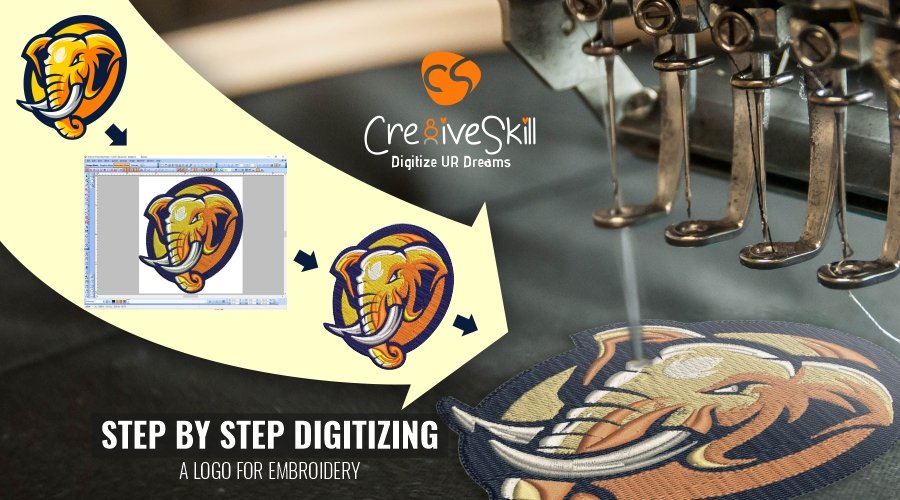Affordable Digitizing for Embroidery: Precision and Detail
Affordable Digitizing for Embroidery: Precision and Detail
Blog Article
Understanding the Embroidery Digitizing Process: Your Ultimate Overview
Embroidery digitizing is a precise craft that requires precision and know-how to convert intricate styles right into electronic formats for maker needlework. As artisans start this trip to master the needlework digitizing procedure, a detailed understanding of the basics sets the structure for quality. However, beyond the fundamental expertise lies a world of advanced software program, specialized devices, and nuanced techniques waiting to be checked out. By diving right into the subtleties of digitizing, one can open a globe of imaginative opportunities and boost their needlework tasks to brand-new elevations.

Comprehending Needlework Digitizing Basics
Needlework digitizing fundamentals develop the structure upon which complex styles are converted right into machine-readable styles for exact sewing. This preliminary action in the embroidery digitizing process is important for ensuring that the final embroidered product is a loyal depiction of the initial style. Comprehending embroidery digitizing fundamentals involves understanding key concepts such as stitch types, sew instructions, thickness, rug, and pull compensation.
Stitch kinds play an essential duty in figuring out the visual and textural outcome of the embroidered layout. By picking the proper stitch type, whether it be satin, fill, or running stitch, digitizers can attain the wanted impact and improve the overall quality of the needlework. Furthermore, stitch instructions affects the flow and dimension of the layout, while thickness establishes the spacing and insurance coverage of the stitches.
Moreover, rug stitching gives security to the design by safeguarding the textile and protecting against distortion throughout the embroidery procedure. Pull compensation is one more crucial consideration to counteract the natural tendency of textile to contract when sewn. Mastering these needlework digitizing basics is basic for creating professional-quality stitched products.
Selecting the Right Digitizing Software
Selecting the proper digitizing software is an essential decision that substantially influences the efficiency and high quality of the needlework digitizing procedure. Digitizing for Embroidery. When choosing the ideal digitizing software application, it is important to think about aspects such as the intricacy of designs you plan to produce, the user-friendliness of the software application, the degree of consumer support offered, and the compatibility with your embroidery maker
There are different digitizing software choices readily available in the market, ranging from basic programs for novices to sophisticated software program for professional digitizers. Some popular choices include Wilcom EmbroideryStudio, Hatch Embroidery Software, and PulseID. These software packages provide a wide variety of tools and features to help i was reading this you create elaborate designs with simplicity.
Before deciding, it is recommended to check out the different software application options with totally free tests or demonstrations to figure out which one finest fits your needs. Additionally, reading testimonials and looking for referrals from seasoned digitizers can give important understandings into the toughness and weaknesses of each software plan (Digitizing for Embroidery). By very carefully assessing your requirements and contrasting the functions of different digitizing software program, you can make an educated choice that improves your embroidery digitizing operations
Digitizing Devices and Strategies

Optimizing Design Settings for Embroidery
Mastering the details of style setups is fundamental in accomplishing optimal results in the needlework digitizing process, structure upon the structure laid by comprehending digitizing devices and techniques. When enhancing design setups for needlework, it is vital to take into consideration aspects such as stitch kind, density, rug, draw compensation, and registration. Enrollment setups align various components of the design precisely, maintaining total style stability.

Troubleshooting Common Digitizing Issues
When running into common digitizing issues throughout the needlework process, it is important to comprehend the origin and carry out effective services without delay. One common trouble is stitch thickness issues, where stitches might be also dense, triggering the textile to pucker, or as well thin, leading to spaces in the layout. Readjusting the stitch density setups in the digitizing software can help solve this problem.
An additional constant challenge is thread breaks throughout the needlework procedure. This can occur because of numerous factors such as wrong tension settings, dull needles, or utilizing low-grade string. Making certain proper over here maintenance of the needlework machine, including routine needle modifications and stress changes, can decrease the occurrence of thread breaks.
Furthermore, design registration errors can lead to misaligned aspects within the needlework style. Examining the layout placement in the digitizing software and making needed changes prior to sewing can assist in avoiding this problem. By dealing with these typical digitizing problems quickly and successfully, you can make sure a smoother needlework process and top notch ended up items.
Final Thought
In verdict, understanding the needlework digitizing procedure requires a strong understanding of the fundamentals, the best choice of software, and knowledge of tools and methods. Enhancing style settings and troubleshooting usual digitizing concerns are vital actions in guaranteeing top quality needlework results. By complying with these steps carefully, one can achieve precision and performance in the digitizing procedure.
Report this page